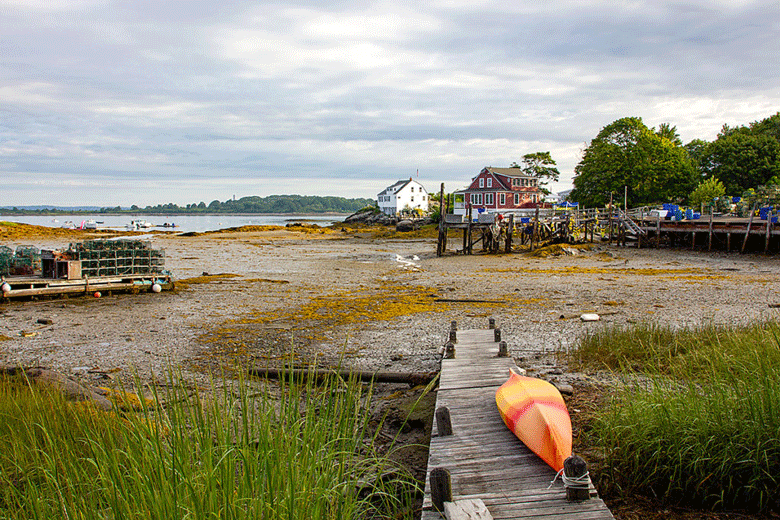The sun is sinking and fills the kitchen with an orange glow, signaling the end of a long week. Lobster traps hauled and stacked, gear shifted from one spot in the ocean to another. Lunches made in the dark and fishing boots brought in to dry. Nights of nodding off before supper and sunrises streaming in through salty wheelhouse windows.
His hands are calloused from endless line: coiling, tying, pulling, but also from guitar strings, and tonight is for the music.
So many artists have found havens on Maine’s islands, trading cityscapes and subway stairwells for slow moving ferry boats and ledges made of shale and granite.
There’s no shortage of inspiration: the stark and simple beauty and the way the sky can shift from broody, heavy grays to sweeping reds and oranges. The pine forests are layered, green on green on green, disrupting the lines of the nearest shore and giving painters and photographers and poets much to ponder.
There’s just something about an island that draws artists of all types.
But there’s also something about an island that seems to create artists. Where I live, on Long Island in Casco Bay (and surely this is true for many year-round residents, both generational and transplants) art can be as grounding, as foundational, as necessary as any of the work we do. And we do work hard.
There are plenty like me: creative folks who were drawn to this place for love or solitude or adventure.
I’m from away. Almost 20 years ago, I married a 4th generation fisherman. He is also a father, guitar player (taught how to play music and run a boat through blinding fog by the same man), illustrator, singer, and fixer of most things.
I’m also a mother, a teacher, a writer, and a fiddle player, and there hasn’t been one part of who I’ve grown to be, who we’ve grown to be, that hasn’t been touched or brushed or enhanced by our island surroundings. And the most important are the people of our community.
There are plenty like me: creative folks who were drawn to this place for love or solitude or adventure. We have potters, woodworkers, singers, bakers, writers—all who came and stayed, adding new branches to tangled family trees or just planting roots of their own.
But there are even more who have had their entire lives shaped by this place. People who mix work and art, people who have to make room for it, look for it, find it in each other, and share it. Creativity flows in the water and in the blood of the people here and their art—our art— the art we make together and separately, has a richness and a depth that can’t be replicated.
Like the photographs of the sunset rippling on the water’s surface, songs sung in kitchens or tiny band rooms where seaglass lines the shelves alongside the guitar picks and harmonicas.
Like careful woodworking, the salvage of a 100-year-old chair or mantle or staircase, tiny scenes painted on mussel shells, jewelry crafted from what the sea left at low tide, poems written just to not forget the smell of spring or the day someone was taken by the sea. Paintings made by a granddaughter, looking out the same window over the same cove as many women before her.
And art in more unconventional forms—the letters on the bow of a boat, meticulously chosen to match the captain’s demeanor, and smoothed to perfection; line and function, beauty and power, all fabricated and modified by a boatbuilder, whose handmade toy boats are scattered around the living rooms of island children; spliced rope and mended nets; the miracle hands of a mechanic, black-stained fingers coaxing a tired engine back to life.
The wandering gardens with vines that overflow with enough food to share with neighbors and last deep into winter, and flowers to adorn a best friend’s driftwood wedding arbor; a workshop so tidy, you can probably find anything you need, and also a workshop so haphazard you’ll never find anything without the help of the lobsterman who spends his evenings and stormy days in there.
Seared scallops, cooked by the fisherman who plucked them from the dragger’s chain and then shucked their fat bodies from sharp shells with masterful rhythm and speed; freshly painted buoys hanging to dry in the yard, a banner of hope and determination.
The necessity of ingenuity and resourcefulness in these remote places is striking, as is the deep connection to water, land, and community.
And within these tightly woven traits shaped by geography and history, art lives and breathes. Intergenerational gatherings where music is at the core, and children dance alongside parents and grandparents, are common here. There are tie-dye parties and scallop shell mobiles and neighbors who know how to heal what’s broken, whether it’s with blueberry muffins or a spare part.
Do we live here because we’re inspired, or are we inspired because we live here? The gifts of these islands are boundless: food from the sea, clean beaches, solace, closeness to each other. Also a house cleaner with a voice that can fill a community hall and her husband who can play anything with strings, mechanics who revive, mothers who can make something from nothing, and lobstermen, who, at the end of the week always have time for one more song.
Katie Norton teaches at Long Island’s school.





